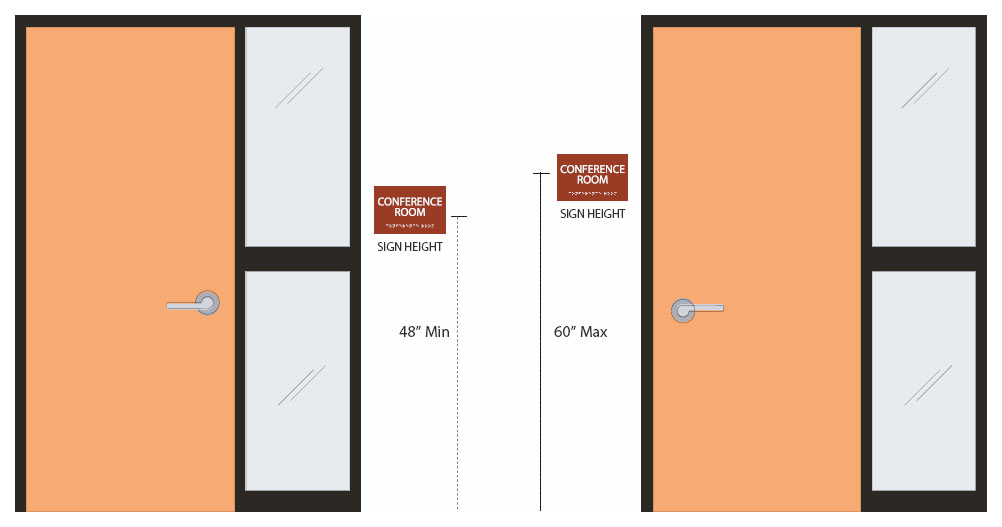Recognizing the Regulations Behind ADA Signs
Recognizing the Regulations Behind ADA Signs
Blog Article
ADA Signage: Guaranteeing Availability and Compliance in Public Spaces
ADA signs plays a vital function in ensuring availability and conformity within public rooms, significantly adding to an inclusive environment for individuals with handicaps. As we discover the nuances of ADA signs, from responsive features to develop ins and outs, it's critical to consider how these elements coalesce to copyright the civil liberties of all customers.
Relevance of ADA Signage
In contemporary society, the importance of ADA signage expands past simple conformity with lawful requireds to personify a dedication to inclusivity and access for all people. These indicators are essential in creating atmospheres where individuals with specials needs can browse public areas with the same ease and independence as those without handicaps. By giving clear and standard info, ADA signs makes sure that everybody can access centers, solutions, and details without obstacles.
The value of ADA signage hinges on its capability to boost the lifestyle for people with impairments by advertising equal access. It gets rid of the obstacles that could otherwise hinder their capacity to participate totally in community life. In addition, these indications offer as visible indications of an organization's devotion to diversity and equal rights, mirroring wider social values that champion the civil liberties and self-respect of all individuals.
Furthermore, ADA signs plays a vital role in public security. By leading individuals to departures, toilets, and other crucial facilities, it guarantees that all individuals, no matter physical ability, can evacuate safely during emergency situations. In recap, ADA signage is not just a regulative demand yet an effective device for fostering a equitable and comprehensive society.
Trick Elements of Compliance

Positioning is essential; indicators must be set up in locations that are easily visible and obtainable. Commonly, signs needs to be installed between 48 and 60 inches from the ground to guarantee ease of access for both standing and wheelchair customers. Tactile elements, such as Braille, are essential for people with aesthetic impairments, providing critical information in a non-visual format.
High-contrast shades between the text and history are needed to improve readability for individuals with low vision. The ADA mandates details comparison ratios to ensure quality. Furthermore, character size is an essential factor to consider, with minimal height needs dictated by the viewing range to guarantee readability from numerous angles.
Layout Factors To Consider for Ease Of Access
Designing easily accessible signage calls for a thorough method to guarantee it satisfies the needs of all individuals, particularly those with handicaps. This entails taking into consideration various layout elements that improve readability and usability. Secret factors include the selection of font, shade contrast, and responsive functions. Typefaces ought to be sans-serif, with clear and simple letterforms, to facilitate simple analysis. The size of the text is similarly crucial, with ADA guidelines recommending a minimal height based on viewing range to make certain legibility.
Contrasting colors in between message and history are crucial for exposure, particularly for individuals with visual impairments. A high contrast ratio assists differentiate the message from its history, boosting readability under numerous lights problems. In addition, responsive components, such as Braille and elevated personalities, are vital for people that are blind or have reduced vision. These aspects must be found at a constant elevation and placement to guarantee very easy access and comprehension.
In addition, the placement of signs plays a significant role in accessibility. Signs should be installed in places that are easily obtainable and unhampered. Making certain that signage is installed at appropriate heights and angles allows all users, consisting of those using mobility devices, important link to engage with them effectively.
Typical Blunders to Avoid

One more prevalent error is the wrong placement of signage. ADA guidelines define accurate height and place demands to make certain that signs are quickly visible and reachable by all individuals, including those using wheelchairs. Ignoring these guidelines not only hampers ease of access however additionally risks non-compliance with lawful requirements.
In addition, not enough contrast in between message and background is a constant oversight. Adequate comparison is essential for readability, particularly for people with low vision. Designers occasionally select colors that are aesthetically enticing however lack the necessary comparison, rendering the text hard to discern.
Last but not least, some developers stop working to integrate tactile components, such as Braille, which are critical for individuals that are blind. Omitting these features not just leads to non-compliance with ADA laws yet likewise limits gain access to for a sector of the population that depends on responsive information.
Future Trends in Signs
Innovations in innovation and enhancing awareness of inclusivity are forming the future fads in signs layout. As culture becomes extra aware of varied demands, the integration of smart modern technologies right into signs is acquiring grip. Digital signage, for example, is evolving to consist of real-time updates and interactive attributes, which can be critical in providing dynamic information in public spaces. These indications frequently incorporate touch displays or gesture-based controls, making it possible for users to browse content customized to their specific needs.
Another emerging pattern is the usage of enhanced reality (AR) to enhance customer experience. AR-enabled signage can overlay digital information onto the physical atmosphere, giving visually impaired individuals with auditory or haptic comments. ADA Signs. This modern technology not just enhances availability yet also develops an appealing experience for all users
Sustainability is likewise a substantial factor affecting signage patterns. Green materials and energy-efficient illumination remedies are being prioritized to align with international ecological objectives. Moreover, improvements in products science are resulting in the advancement of even more sturdy and weather-resistant signs.
Final Thought
ADA signs plays a vital function in guaranteeing availability and compliance within public spaces by incorporating tactile aspects, high-contrast shades, and calculated positioning. The adherence to ADA standards not just helps with secure navigating for individuals with impairments however additionally signifies a company's commitment to variety and inclusivity. By avoiding typical errors and welcoming future fads, public spaces can remain to advance these values, making certain that the civil liberties and self-respect of all people are respected and maintained.
ADA signage plays an essential duty in guaranteeing availability and conformity within public spaces, considerably adding to an inclusive atmosphere for people with handicaps. As we discover the nuances of ADA signs, from responsive functions to design intricacies, it's essential to think about just how these components integrate to support the legal rights of all users.In contemporary society, the importance of ADA signs prolongs past mere compliance with lawful mandates to find this symbolize a dedication to inclusivity and accessibility for all individuals. By supplying clear and standardized info, ADA signage guarantees that every person can access facilities, solutions, and details without barriers.
ADA signage plays a crucial function in assuring accessibility and conformity within click for source public spaces by including tactile components, high-contrast colors, and critical positioning. (ADA Signs)
Report this page